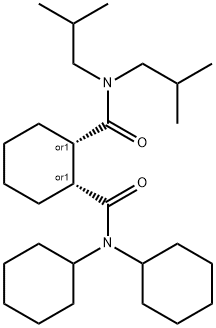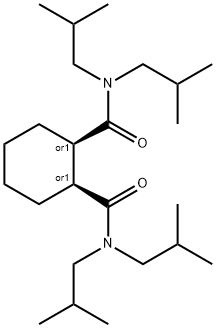TRIISOBUTYLAMINE
- CAS NO.:1116-40-1
- Empirical Formula: C12H27N
- Molecular Weight: 185.35
- MDL number: MFCD00040501
- EINECS: 214-236-9
- SAFETY DATA SHEET (SDS)
- Update Date: 2025-01-27 09:38:02

What is TRIISOBUTYLAMINE?
Chemical properties
Triisobutylamine is flammable.
The Uses of TRIISOBUTYLAMINE
Triisobutylamine is suitable to develop second generation ionic liquid matrices for MALDI-MS of peptides, proteins and carbohydrates. It may be used in the separation of cis-fatty acid salts and and trans-fatty acid (elaidic acid) salts using a new organic solvent nanofiltration membrane based on polydicyclopentadiene. It may be used as base in the synthesis of acroyl ammonium derivatives.
What are the applications of Application
Triisobutylamine is suitable to develop second generation ionic liquid matrices for MALDI-MS of peptides, proteins and carbohydrates
Production Methods
Triisobutylamine is manufactured from isobutanol and ammonia under heat and pressure.
General Description
Clear pale yellow liquid.
Air & Water Reactions
Insoluble in water.
Reactivity Profile
TRIISOBUTYLAMINE neutralizes acids in exothermic reactions to form salts plus water. May be incompatible with isocyanates, halogenated organics, peroxides, phenols (acidic), epoxides, anhydrides, and acid halides. Flammable gaseous hydrogen may be generated in combination with strong reducing agents, such as hydrides.
Health Hazard
ACUTE/CHRONIC HAZARDS: Toxic.
Fire Hazard
TRIISOBUTYLAMINE is combustible.
Properties of TRIISOBUTYLAMINE
| Melting point: | -21.8°C |
| Boiling point: | 192-193 °C/770 mmHg (lit.) |
| Density | 0.766 g/mL at 25 °C (lit.) |
| refractive index | n |
| Flash point: | 135 °F |
| form | clear liquid |
| pka | pK1:10.42(+1) (25°C) |
| color | Colorless to Almost colorless |
| BRN | 1698950 |
| EPA Substance Registry System | Triisobutylamine (1116-40-1) |
Safety information for TRIISOBUTYLAMINE
| Signal word | Danger |
| Pictogram(s) |
 Flame Flammables GHS02  Corrosion Corrosives GHS05  Skull and Crossbones Acute Toxicity GHS06 |
| GHS Hazard Statements |
H226:Flammable liquids H302:Acute toxicity,oral H315:Skin corrosion/irritation H318:Serious eye damage/eye irritation |
| Precautionary Statement Codes |
P210:Keep away from heat/sparks/open flames/hot surfaces. — No smoking. P280:Wear protective gloves/protective clothing/eye protection/face protection. P301+P312:IF SWALLOWED: call a POISON CENTER or doctor/physician IF you feel unwell. P303+P361+P353:IF ON SKIN (or hair): Remove/Take off Immediately all contaminated clothing. Rinse SKIN with water/shower. P305+P351+P338:IF IN EYES: Rinse cautiously with water for several minutes. Remove contact lenses, if present and easy to do. Continuerinsing. |
Computed Descriptors for TRIISOBUTYLAMINE
New Products
1-Amino-1-cyclohexanecarboxylic acid Cycloleucine 6-Bromo-3-iodo-1-methyl-1H-indazole 3-(2,4-Dimethoxybenzyl)dihydropyrimidine-2,4(1H,3H)-dione 7-Bromo-1H-indazole ELECTROLYTIC IRON POWDER 2-Methyl-2-phenylpropyl acetate 1-Aminocyclobutanecarboxylic acid 1-(2-Ethoxyethyl)-2-(piperidin-4-yl)-1H-benzo[d]imidazole hydrochloride Decanonitrile tert-butyl 4-(1H-benzo[d]iMidazol-2-yl)piperidine-1-carboxylate 4-Ethylbenzylamine Methyl 5-bromo-2-chloro-3-nitrobenzoate N-(5-Amino-2-methylphenyl)acetamide 2-Chloro-3-nitropyridine 5-Bromo-2,3-dimethoxypyridine methyl 6-chloro-2-(chloromethyl)nicotinate 2-methoxy-4-methyl-5-nitro pyridine 2-iodo-5-bromo pyridine 2-amino-4-methyl-5-nitro pyridine 5-Fluoro-2-Oxindole methyl L-alaninate hydrochloride diethyl L-glutamate hydrochloride Ethyl tosylcarbamateRelated products of tetrahydrofuran


![5-METHYL-7-PHENYL-2-(1,2,3,4-TETRAHYDROXY-1,2,3-TRIMETHYLBUTYL)-1,3-DIAZATRICYCLO[3.3.1.1~3,7~]DECAN-6-ONE](https://img.chemicalbook.in/StructureFile/ChemBookStructure9/GIF/CB2710767.gif)





You may like
-
 Triisobutylamine CAS 1116-40-1View Details
Triisobutylamine CAS 1116-40-1View Details
1116-40-1 -
 Ethoxymethylenemalononitrile 99% HPLCView Details
Ethoxymethylenemalononitrile 99% HPLCView Details
123-06-8 -
 3-hydroxy-2-nitrobenzoic acid 602-00-6 98%View Details
3-hydroxy-2-nitrobenzoic acid 602-00-6 98%View Details
602-00-6 -
 Diethyl Disulfide 99% HPLCView Details
Diethyl Disulfide 99% HPLCView Details
110-81-6 -
 6285-05-8. 1-(4-chlorophenyl) propan-1-one 98%View Details
6285-05-8. 1-(4-chlorophenyl) propan-1-one 98%View Details
6285-05-8. -
 4-chloro-3,5-dinitropyridine 98%View Details
4-chloro-3,5-dinitropyridine 98%View Details -
 401-95-6 99% HPLCView Details
401-95-6 99% HPLCView Details
401-95-6 -
 171663-13-1 tert-Butyl 3-bromobenzylcarbamate 98%View Details
171663-13-1 tert-Butyl 3-bromobenzylcarbamate 98%View Details
171663-13-1